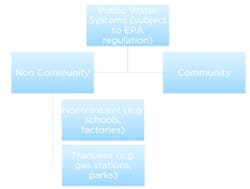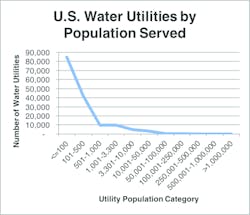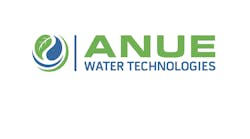The U.S. has an unusual and fragmented network of water systems. More than 150,000 systems serve nearly 320 million Americans, with an average of 2,000 individuals per utility and about 500 endpoints. The U.K., by comparison, has only 32 regulated water utilities that serve a population of around 64 million, which equates to approximately 2 million users per utility or approximately 500,000 endpoints. Australia looks similarly consolidated with nearly 19 million people out of a population of 23 million served by just 82 water suppliers. This equals about 230,000 people per utility.
More than 286 million Americans get their tap water from a community water system. Of these, 8 percent of the community water systems — large municipal water systems — provide water to 82 percent of the U.S. population.
Different water systems
Figure 1. U.S. water system category framework
The U.S. has several different types of water systems, and they are categorized as either community or non-community.
A community water system supplies water to the same population year-round. It serves at least 25 people at their primary residences or at least 15 residences that are primary residences (for example, municipalities and mobile home park subdivisions).
Non-community water systems are composed of both transient and non-transient water systems that include:
- Transient non-community water systems (TNCWS) provide water to 25 or more people for at least 60 days per year but not to the same people and not on a regular basis (for example, gas stations and campgrounds).
- Non-transient non-community water systems (NTNCWS) regularly supply water to at least 25 of the same people at least six months per year but not year-round (for example, schools; factories; office buildings; and hospitals, which have their own water systems).
Of the roughly 155,000 water systems in the U.S., community systems account for about 52,000 (34 percent) and provide water to more than 286 million Americans. For non-community systems, TNCWS account for 84,000 (54 percent), and NTNCWS make up 19,000 (12 percent). Because community systems are the most familiar water utility, the remainder of this article will focus on these systems.
Figure 2. Distribution of U.S. water utilities by population served
As seen in Figure 2, a vast majority of community water systems serve a relatively small number of customers. This substantial fragmentation has several implications for the industry that have created some significant operating challenges for smaller system managers that include:
- Small systems with a modest number of customers have a limited revenue base to finance their operations. In addition, a vast majority of these small systems are in rural areas where customers tend to be on the lower end of the socioeconomic spectrum. This means that small utilities are particularly challenged to pass rate increases to fund critical infrastructure investments to maintain reliability and quality.
- Many small communities face stable or declining demand and have few prospects for economic growth. Unlike many urban or suburban suppliers that can look to the future for new customers, rural systems do not have the luxury of system growth to support ongoing system rehabilitation investments.
- The resources needed to manage payments, customer support, financial operations and other back-office functions are often stretched and highly manual. These functions are not performed at scale and are under-resourced, so they are riddled with inefficiencies.
An underlying challenge for these smaller systems is that the industry network of vendors for equipment such as pipes, pumps, modern data analytics and customer communication platforms are focused on serving the largest, most lucrative water utility customers. With long utility sales cycles, it makes sense that vendors focus on limited go-to-market resources targeting the biggest water suppliers and leaving many of the smaller utilities dramatically underserved.
Also, some vendors may price their products to gain as much revenue as possible from the largest customers. While this business model makes sense from the vendor perspective, the inherent scale differences between the few largest and many more smaller suppliers lead to a significant imbalance in services designed, priced and targeted to smaller water utilities.
The need for consolidation
Water treatment and delivery is a high-capital, intensive endeavor, and creating a water distribution grid similar to the nationally interconnected electric grid is not possible. Unlike electrons, which are very light and relatively easy to transport, water is too heavy and expensive to transport across long distances. Therefore, in practice, those in the water industry must use water distribution systems that rely on local sources of supply to meet the needs of regional communities.
However, many other aspects of water utility operations do not rely on physical infrastructure. Processes including billing, payments and custo-mer support typically rely on information technologies, and these services do not depend on physical proximity to the end user. While it may be true that the water supply must be within a relatively short distance from the customer, the systems and people that provide back-office services can be nearly anywhere in the world.
This is the area that is ripe for greater consolidation within the water utility industry. If smaller utilities band together to negotiate and offer these information services at scale across different communities, service costs per unit will decline, offering better operating margins for utility managers and providing more consistent quality of service to residents.
Community pride
A number of factors have conspired to discourage greater consolidation within the industry. Because most
water utilities are municipally managed, communities have an understandably strong sense of pride in their water systems and often are uncomfortable with the notion of outsourcing certain aspects of operations. In addition to the emotional connection to providing quality and reliable water service to the local jurisdiction, municipal operators provide jobs to members of the community. Few city council members or mayors want to send local jobs to a centralized operation center, even if it results in lower costs and higher service quality for residents.
In addition, for this model to work at scale, water consumption, service address, billing information and other customer-specific data need to be delivered to centralized customer information and billing systems in a consistent, repeatable format. The range of existing platforms from a large set of solution vendors and many homegrown billing, payment, customer relationship management and communication systems are found throughout the industry, so transitioning multiple water suppliers to systems capable of consistently interfacing with each other is a daunting challenge.
Bridging the gap
Future consolidation within the industry is inevitable as operations and capital costs continue to rise and the long-term benefits of scaled, back-office operations become more apparent. However, what can smaller communities do in the short term to gain some of these benefits at low cost?
Fortunately, a new generation of data analytics and customer engagement technologies is emerging, built on years of development experience and feedback from larger water suppliers. These systems offer all the digital communication capabilities found in modern customer-facing service organizations including Web and mobile applications, email, text messaging, automated voice and interactive voice response features.
These communications include robust data analysis platforms that support modern customer relationship management interfaces to help utilities proactively communicate with customers, accelerate call resolution, reduce payment delinquency, drive improvements in operational efficiency, and inform operating and capital investments by better forecasting the outcomes of different programs. This information is accessible using a smartphone, tablet or computer.
While this new breed of technologies does not resolve the fundamental fragmentation problem, it begins to bridge the gap between large and small suppliers and addresses the expectations of residents or consumers regarding data access and transparency. In an industry that is known for its risk aversion and slow evolution, this advancement should be hailed as a victory for smaller business.
Jeff Lipton manages WaterSmart Software’s go-to-market strategy development and marketing campaign activities, along with sales operations support. WaterSmart Software empowers water utility managers with actionable insights from data to help increase customer satisfaction, reduce unaccounted for water loss and improve operational efficiency. Utilities using WaterSmart’s award winning cloud-based, analytics and customer engagement platform have demonstrated an increase in customer satisfaction of more than 35 percent. For details visit watersmart.com or follow
@GetWaterSmart on Twitter.




